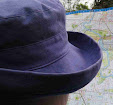 |
| Stand hurdles, Flemington. Photographer Frederick E Murphy, album "Horse racing and steeplechasing in Victoria and Tasmania." Courtesy of the State Library of Victoria Collection, H81.189/2/11. |
 |
| Harry Harrison's "Jessamine" stables from a Sporting Globe story in 1933: http://nla.gov.au/nla.news-article181750708 Thanks to Alex Bragiola for this illustration. |
 |
| Looking south along Westbourne St, Harrison's training track can be seen on the corner of Epsom Rd with the house to the right of that.. Thanks again to Alex Bragiola. |
During the week he schooled horses over hurdles and brush fences for Harrison, often in company with another jockey, Reuben Koops. Koops joined the AIF a few weeks before Fred, and ended up in the 4 Light Horse Regiment.
The track newspaper correspondent generally wrote positive remarks about Fred's trackwork:
Sylvan Maid (Mr. W. Morrison) did well for a beginner in a school over hurdles with the Dunkeld gelding (J. Nicholls) who subsequently jumped fences in excellent style. Milkabah (F. Botterill) was to have gone with this pair, but he has a will of his own, and preferred a caper on his own account, but after his rider had got the upper hand he was sent over the brush hurdles, which were jumped in a satisfactory manner.However, Bottrill's name rarely appeared as a placegetter. He did get a run in the Melbourne Cup Steeplechase in 1912, but failed to get a place.
ROUND ABOUT FLEMINGTON. (1913, June 7). The Australasian (Melbourne, Vic. : 1864 - 1946), p. 19. http://nla.gov.au/nla.news-article142964384
In May 1914 Fred appears to have left the Harrison stables, and was working in Adelaide when a mishap occurred:
The only other accident on Saturday was in the Steeplechase, and when Darcy fell F. Botterill, an English boy who is in T. Keily's stable, had his arm injured, how severely was not known, as Dr. Cavenagh-Mainwaring thought that probably only the X-rays would reveal this.One can only assume that the injury wasn't too serious, as three weeks later Fred was racing again at Port Adelaide racetrack when a very serious pile-up occurred involving five horses and jockeys:
SPORTING GOSSIP. (1914, May 20). Port Pirie Recorder and North Western Mail (SA : 1898 - 1918), p. 4. http://nla.gov.au/nla.news-article95331538
It was in the Franklin Hurdle Race that the most serious accident occurred. At the first hurdle five horses fell in a bunch. It is difficult to say which horse started the trouble. Some people say it was Reveller, others Kanyaka, and others that the two fell together. But whichever it was to first kiss Mother Earth was the one that did the damage, for in less time than it takes to tell it the horses following were in a general mix up, and the excited animals kicked and struggled in their efforts to rise in a manner that made it difficult to understand how any of the jockeys who came down escaped death. Fortunately two of the riders - T. Ryan and G. Hale - who were on The Amendment and Bucksey respectively, were thrown clear, and they suffered no injury. A. D. Frazer (Kanyaka), W. Shaw (Thrifty Lass), and F. Botterill (Reveller) were not so fortunate, and they were all injured, more or less seriously.Frazer and Botterill were unconscious when picked up, and Shaw, though conscious, was bleeding freely from a wound on the head. When the ambulance waggon delivered its unfortunate freight at the casualty room Dr Griffiths found that Shaw's left ear was nearly severed, evidently from a kick. An anaesthetic was at once administered and the ear sewed on again. An examination of Frazer showed that he was suffering from slight concussion of the brain, but Botterill was found to be very badly hurt, his skull being fractured. It also appeared as though there was compression on the brain. As soon as possible he was removed to the Adelaide Hospital, where he was operated on by Dr. Smeaton. Upon enquiry last night it was ascertained that his condition was critical.SERIOUS FALLS (1914, June 15). Daily Herald (Adelaide, SA : 1910 - 1924), p. 5. http://nla.gov.au/nla.news-article125062482
When recruiting for the war began in August 1914, Botterill may well have still been in hospital, but had he made it to a recruiting office, he would have been considered too short. Twelve months on the losses of troops which occurred at Gallipoli forced the Army to reconsider its standards, and in September 1915 he was considered to be a strapping young chap, eminently suitable to carry a pack and rifle. It doesn't seem probable that he was still a working jockey after the serious head injury he had suffered the year before, and by putting that occupation on his B2455 he may have been harking back to his glory days.
He had no family to whom he could leave his slender estate, but he told his friend Miss Morgan of 32 Barnett St, Kensington that he wanted her to have anything he was owed.
Rod Martin tells the story of Fred Botterill, the jockey who went missing.












No comments:
Post a Comment